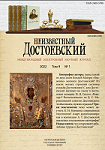Как найти дом Достоевских? (Заметки по поводу несостоявшейся сенсации)
Searching for the Dostoevsky House (Notes on the Failed Sensation)
Author(s): Albina Stanislavovna Bessonova, Vladimir Aleksandrovich ViktorovichSubject(s): Archaeology, Cultural history, Museology & Heritage Studies, Architecture, 18th Century, 19th Century
Published by: Петрозаводский государственный университет
Keywords: Dostoevsky’s Darovoe Manor; interdisciplinary research; archeology; interpretation; comprehensive analysis of sources;
Summary/Abstract: The article presents the facts that contradict A. S. Syrovatko’s statement, which claims that the current territory of the Museum is not related to the Dostoevsky estate (The Unknown Dostoevsky. 2021. Vol. 8. No. 4). When studied objectively, the objects found during the excavations do not contradict the presence of “traces of Dostoevsky.” The so-called memorial period of estate ownership by the writer’s parents, which lasted only seven years, was unable to leave too many traces, and the objects found by archaeologists in the 18th — early 19th centuries could have been used by the Dostoevsky family up to 1830s. Additional arguments are introduced to resolve the dispute: the result of the dendrological examination and written sources (previously known and recently discovered), namely, boundary plans, memoirs and diaries of A. M. Dostoevsky, family correspondence. The proposed comprehensive approach and a comparison of all the currently available sources, allows us to attribute the location of the Dostoevsky manor house to the preserved wing where the museum was recently opened. In connection with the problem of identification of the museum house, the hypotheses of other authors are considered (T. N. Dementieva and L. A. Tarasova, L. A. Voronkina) about the cardinal changes that took place in the architecture of the manor Darovoe at different times. Sources indicate, on the contrary, a certain continuity in the development of the estate under all three of its owners: the Khotyaintsev, Dostoevsky and Ivanov families. The key factor is the location of two “mounds” under the lime trees as “green canteens” tied to the manor house, and on the other side, the border between the landowner’s estate and peasant homesteads remained unchanged (as confirmed by archival documents and the boundary wall and moat preserved). Conservative localization is characteristic of the life in a noble estate, once and forever inscribed in the surrounding landscape. Taking into account the experience of their predecessors, the Dostoevskys and Ivanovs did not make radical changes to the space inhabited before them, and their house did not change its location.
Journal: Неизвестный Достоевский
- Issue Year: 9/2022
- Issue No: 1
- Page Range: 20-37
- Page Count: 18
- Language: Russian

